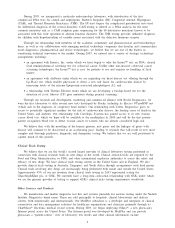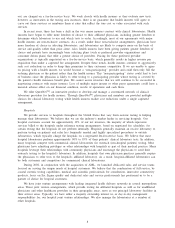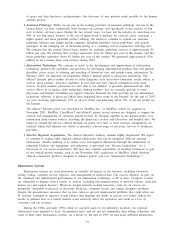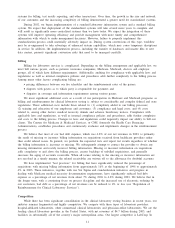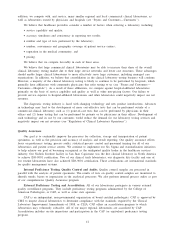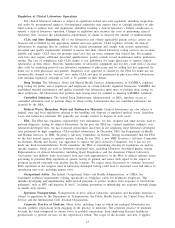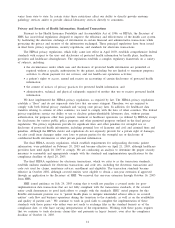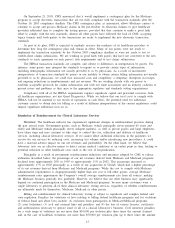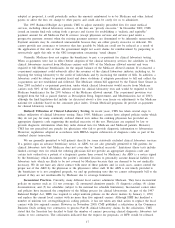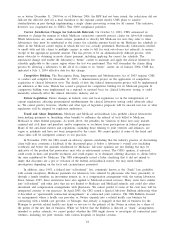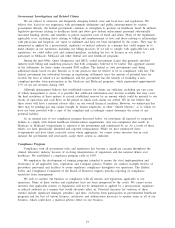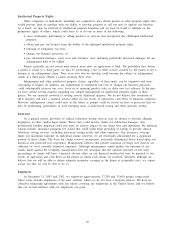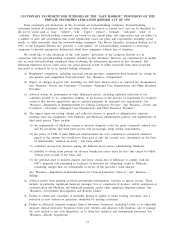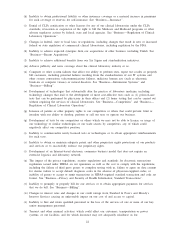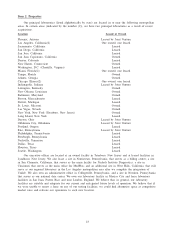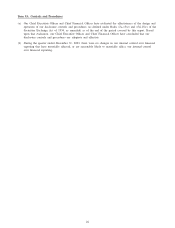Quest Diagnostics 2003 Annual Report Download - page 33
Download and view the complete annual report
Please find page 33 of the 2003 Quest Diagnostics annual report below. You can navigate through the pages in the report by either clicking on the pages listed below, or by using the keyword search tool below to find specific information within the annual report.of remuneration involved. A parallel civil remedy under the federal False Claims Act provides for damages not
more than $11,000 per violation plus up to three times the amount claimed.
Reduced Reimbursements. In 1984, Congress established a Medicare fee schedule payment methodology
for clinical laboratory services performed for patients covered under Part B of the Medicare program. Congress
then imposed a national ceiling on the amount that carriers could pay under their local Medicare fee schedules.
Since then, Congress has periodically reduced the national ceilings. The Medicare national fee schedule
limitations were reduced in 1996 to 76% of the 1984 national median of the local fee schedules and in 1998 to
74% of the 1984 national median. The national ceiling applies to tests for which limitation amounts were
established before January 1, 2001. For more recent tests (tests for which a limitation amount is first established
on or after January 1, 2001), the limitation amount is set at 100% of the median of all the local fee schedules
established for that test in accordance with the Social Security Act. The Balanced Budget Act of 1997
eliminated the provision for annual increases to the Medicare national fee schedule based on the consumer price
index from 1998 through 2002. A 1.1% increase based on the consumer price index became effective on
January 1, 2003. The Prescription Drug, Improvement, and Modernization Act of 2003 eliminated for five years
(beginning January 1, 2004) the provision for annual increases to the Medicare national fee schedule based on
the consumer price index, including the adjustment (which would have been 2.6%) that had been scheduled for
January 1, 2004. Thus, by law an adjustment to the national fee schedule for clinical laboratory services based
on the consumer price index cannot occur before January 1, 2009.
Pathology services are reimbursed by Medicare based on a resource-based relative value scale, or RBRVS
that is periodically updated by CMS. Less than 1% of our net revenues are derived from pathology services
reimbursed by Medicare based on RBRVS.
With regard to the rest of our laboratory services performed on behalf of Medicare beneficiaries, we must
bill the Medicare program directly and must accept the carrier’s fee schedule amount as payment in full. In
addition, state Medicaid programs are prohibited from paying more (and in most instances, pay significantly
less) than Medicare. Major clinical laboratories, including Quest Diagnostics, typically use two fee schedules for
tests billed on a fee-for-service basis:
•“Client’’ fees charged to physicians, hospitals, and institutions for which a clinical laboratory performs
testing services on a wholesale basis and which are billed on a monthly basis. These fees are generally
subject to negotiation or discount.
•“Patient’’ fees charged to individual patients and third-party payers, like Medicare and Medicaid. These
fees generally require separate bills for each requisition.
The fee schedule amounts established by Medicare are typically substantially lower than patient fees
otherwise charged by us, but are sometimes higher than our fees actually charged to certain other clients.
During 1992, the Office of the Inspector General, or OIG, of the HHS issued final regulations that prohibited
charging Medicare fees substantially in excess of a provider’s usual charges. The OIG, however, declined to
provide any guidance concerning interpretation of these rules, including whether or not discounts to non-
governmental clients and payers or the dual-fee structure might be inconsistent with these rules.
A proposed rule released in September 1997 would have authorized the OIG to exclude providers from
participation in the Medicare program, including clinical laboratories, that charge Medicare and other programs
fees that are “substantially in excess of . . . usual charges . . . to any of [their] customers, clients or patients.’’
This proposal was withdrawn by the OIG in 1998. In November 1999, the OIG issued an advisory opinion
which indicated that a clinical laboratory offering discounts on client bills may violate the “usual charges’’
regulation if the “charge to Medicare substantially exceeds the amount the laboratory most frequently charges or
has contractually agreed to accept from non-Federal payers.’’ The OIG subsequently issued a letter clarifying
that the usual charges regulation is not a blanket prohibition on discounts to private pay customers.
In September 2003, the OIG published a Notice of Proposed Rulemaking that would amend the OIG’s
exclusion regulations addressing excessive claims. Under the proposed exclusion rule, the OIG would have the
authority to exclude a provider for submitting claims to Medicare that contain charges that are substantially in
excess of the provider’s usual charges. The proposal would define “usual charges’’ as the average payment from
non-government entities, on a test by test basis, excluding capitated payments; and would define “substantially
in excess’’ to be an amount that is more than 20% greater than the usual charge. We believe that the rule is
unnecessary because Congress has already established fee schedules for the services that the rule proposes to
regulate. We also believe that the rule is unworkable and overly burdensome. Through our industry trade
association, we filed comments opposing the proposed rule and we are working with our trade association and a
coalition of other healthcare providers who also oppose this proposed regulation as drafted. If this regulation is
16


